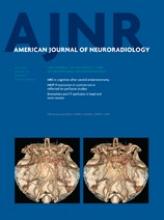Research ArticleExpedited Publication
Open Access
Resolution of Mass Effect and Compression Symptoms following Endoluminal Flow Diversion for the Treatment of Intracranial Aneurysms
I. Szikora, M. Marosfői, B. Salomváry, Z. Berentei and I. Gubucz
American Journal of Neuroradiology May 2013, 34 (5) 935-939; DOI: https://doi.org/10.3174/ajnr.A3547
I. Szikora
aFrom the Departments of Neurointerventions (I.S., M.M., Z.B., I.G.)
M. Marosfői
aFrom the Departments of Neurointerventions (I.S., M.M., Z.B., I.G.)
B. Salomváry
bNeuroophthalmology (B.S.), National Institute of Clinical Neurosciences, Budapest, Hungary.
Z. Berentei
aFrom the Departments of Neurointerventions (I.S., M.M., Z.B., I.G.)
I. Gubucz
aFrom the Departments of Neurointerventions (I.S., M.M., Z.B., I.G.)

Submit a Response to This Article
Jump to comment:
No eLetters have been published for this article.
In this issue
Advertisement
I. Szikora, M. Marosfői, B. Salomváry, Z. Berentei, I. Gubucz
Resolution of Mass Effect and Compression Symptoms following Endoluminal Flow Diversion for the Treatment of Intracranial Aneurysms
American Journal of Neuroradiology May 2013, 34 (5) 935-939; DOI: 10.3174/ajnr.A3547
Jump to section
Related Articles
- No related articles found.
Cited By...
- Mass effect, aneurysms and flow diverters: Is the pipeline embolization device the Lone Virtuoso? Commentary on 'Pipeline embolization device for intracranial aneurysms presenting with mass effect: a large Chinese cohort by Zhao et al
- Pipeline Embolization Device for intracranial aneurysms presenting with mass effect: a large Chinese cohort
- Flow diversion for compressive unruptured internal carotid artery aneurysms with neuro-ophthalmological symptoms: a systematic review and meta-analysis
- Onset-to-treatment time and aneurysmal regression predict improvement of cranial neuropathy after flow diversion treatment in patients with symptomatic internal carotid artery aneurysms
- Pipeline Embolization Device for intracranial aneurysms presenting with mass effect: a large Chinese cohort
- Flow diversion for compressive unruptured internal carotid artery aneurysms with neuro-ophthalmological symptoms: a systematic review and meta-analysis
- Onset-to-treatment time and aneurysmal regression predict improvement of cranial neuropathy after flow diversion treatment in patients with symptomatic internal carotid artery aneurysms
- Flow diversion for internal carotid artery aneurysms with compressive neuro-ophthalmologic symptoms: clinical and anatomical results in an international multicenter study
- Flow Diversion for ICA Aneurysms with Compressive Neuro-Ophthalmologic Symptoms: Predictors of Morbidity, Mortality, and Incomplete Aneurysm Occlusion
- Combined standard bypass and parent artery occlusion for management of giant and complex internal carotid artery aneurysms
- A protocol for the reduction of applied torque on parent vessel during elastase-induced aneurysm formation using rabbit animal models
- How Flow Reduction Influences the Intracranial Aneurysm Occlusion: A Prospective 4D Phase-Contrast MRI Study
- Contemporary endovascular and open aneurysm treatment in the era of flow diversion
- In situ tissue engineering: endothelial growth patterns as a function of flow diverter design
- Intra-aneurysmal flow rates are reduced by two flow diverters: an experiment using tomographic particle image velocimetry in an aneurysm model
- Evolution of Flow-Diverter Endothelialization and Thrombus Organization in Giant Fusiform Aneurysms after Flow Diversion: A Histopathologic Study
- Endoluminal Reconstruction for Nonsaccular Aneurysms of the Proximal Posterior Cerebral Artery with the Pipeline Embolization Device
- Parent Artery Occlusion in Large, Giant, or Fusiform Aneurysms of the Carotid Siphon: Clinical and Imaging Results
- Flow Diversion Versus Conventional Treatment for Carotid Cavernous Aneurysms
- Treatment of Cavernous Sinus Aneurysms with Flow Diversion: Results in 44 Patients
- Unruptured Carotid Artery Aneurysms Presenting with Symptoms of Mass Effect: Outcome after Selective Coiling, Parent Vessel Occlusion, and Flow Diversion
This article has been cited by the following articles in journals that are participating in Crossref Cited-by Linking.
- I. Szikora, E. Turányi, M. MarosfoiAmerican Journal of Neuroradiology 2015 36 9
- Mario Zanaty, Nohra Chalouhi, Robert M. Starke, Guilherme Barros, Mark Philip Saigh, Eric Winthrop Schwartz, Norman Ajiboye, Stavropoula I. Tjoumakaris, David Hasan, Robert H. Rosenwasser, Pascal JabbourStroke 2014 45 9
- R. C. Puffer, M. Piano, G. Lanzino, L. Valvassori, D. F. Kallmes, L. Quilici, H. J. Cloft, E. BoccardiAmerican Journal of Neuroradiology 2014 35 5
- Michael A. Silva, Alfred P. See, Hormuzdiyar H. Dasenbrock, Nirav J. Patel, Mohammad A. Aziz-SultanNeurosurgical Focus 2017 42 6
- Thomas Gaberel, Alin Borha, Camille di Palma, Evelyne EmeryWorld Neurosurgery 2016 87
- Stephen J. Monteith, Asterios Tsimpas, Aaron S. Dumont, Stavropoula Tjoumakaris, L. Fernando Gonzalez, Robert H. Rosenwasser, Pascal JabbourJournal of Neurosurgery 2014 120 4
- F. Clarençon, F. Di Maria, J. Gabrieli, E. Shotar, C. Zeghal, A. Nouet, J. Chiras, N.-A. SourourClinical Neuroradiology 2017 27 1
- Karam Moon, Felipe C. Albuquerque, Andrew F. Ducruet, R. Webster Crowley, Cameron G. McDougallJournal of Neurosurgery 2014 121 5
- Miklos Marosfoi, Erin T Langan, Lara Strittmatter, Kajo van der Marel, Srinivasan Vedantham, Jennifer Arends, Ivan R Lylyk, Siddharth Loganathan, Gregory M Hendricks, Istvan Szikora, Ajit S Puri, Ajay K Wakhloo, Matthew J GounisJournal of NeuroInterventional Surgery 2017 9 10
- Bin Luo, Huibin Kang, Hongqi Zhang, Tianxiao Li, Jianmin Liu, Donglei Song, Yuanli Zhao, Sheng Guan, Aisha Maimaitili, Yunyan Wang, Wenfeng Feng, Yang Wang, Jieqing Wan, Guohua Mao, Huaizhang Shi, Xinjian YangTherapeutic Advances in Neurological Disorders 2020 13
More in this TOC Section
Similar Articles
Advertisement











